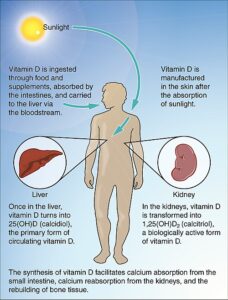Your Circadian Body Clock: How Sunlight Regulates Sleep, Mood, and Health
Ever wonder why you feel energized after a morning walk? Or why you struggle with sleep when you’ve been stuck indoors? Your circadian body clock runs on sunlight. This internal timing system tells your body when to wake, sleep, eat, and even when to repair cells. When you align with natural light cycles, everything from your mood to your metabolism works better.
But here’s the catch: modern life keeps most people indoors. Then at night, artificial light tricks your body into thinking it’s still daytime. This mismatch causes poor sleep, low energy, and health problems that feel mysterious. So understanding how sunlight benefits your circadian rhythm might be the missing piece to your wellness puzzle.
Here’s what you need to know: Your circadian body clock is controlled by a small region in your brain called the suprachiasmatic nucleus (the biological pacemaker). Light signals from your eyes tell this brain region what time it is, then it coordinates your entire body’s schedule. Without proper light exposure, this system falls out of sync.
What Is Your Circadian Body Clock?
Your circadian body clock is your internal 24-hour timer. Also called your circadian rhythm (circadian means “about a day” in Latin), it controls when you feel alert or sleepy. But it does much more than that. This biological clock regulates body temperature, hormone release, digestion, immune function, and cell repair.
The master clock sits in your hypothalamus, specifically in the suprachiasmatic nuclei (SCN). Think of the SCN as a conductor leading an orchestra. Special light-sensing cells in your eyes send signals directly to the SCN, telling it whether it’s day or night. Then the SCN coordinates timing signals throughout your body.
Why Light Matters More Than You Think

Light is the primary “zeitgeber,” which means time-giver in German. Your body evolved to respond to the sun rising and setting. Morning sunlight tells your brain to wake up and stop producing melatonin, while darkness at night signals it’s time for rest. Without these natural cues, your internal clock drifts.
However, artificial lighting changed everything. Office workers might get only 200-400 lux of indoor light during the day. Compare that to outdoor sunlight, which provides 10,000-50,000 lux even on a cloudy day. This dramatic difference explains why many people struggle with energy and sleep despite seemingly normal routines.
100xOutdoor daytime light is up to 100 times brighter than typical indoor lighting. Your circadian clock needs this brightness difference to function properly.
How Sunlight Benefits Your Health
Morning sunlight does something remarkable: it sets your biological clock for the entire day. When bright light enters your eyes in the morning, it triggers a cascade of beneficial effects. Let’s break down exactly what happens and why it matters.
Better Sleep Quality

Morning light exposure is arguably the best natural sleep aid. Research shows that morning sunlight improves sleep quality by regulating your circadian rhythms, not just making you tired at night. When you get bright light early, your body knows to produce melatonin (the sleep hormone) about 14-16 hours later.
But there’s more. Morning light can shift your circadian clock about one hour earlier per day, while evening light shifts it later. This means morning sun exposure naturally helps you fall asleep at a reasonable hour.
Your Morning Light Protocol
Step 1: Get outside within 30-60 minutes of wakingEven 5-10 minutes makes a difference on sunny days. On cloudy days, aim for 15-20 minutes.
Step 2: Don’t wear sunglasses during this timeYour eyes need to detect the light. Regular glasses and contacts are fine, but sunglasses block the beneficial wavelengths.
Step 3: Face the general direction of the sunYou don’t need to stare at the sun (never do this!). Just being outdoors with light reaching your eyes works perfectly.
Step 4: Get a second dose in the afternoon Afternoon sunlight serves as a backup anchor point, helping maintain your circadian rhythm’s stability.
Enhanced Mood and Mental Health

Sunlight’s impact on mood goes beyond just vitamin D. Light exposure influences brain chemistry directly. Bright light triggers serotonin production during the day, which is then converted to melatonin at night. Serotonin is your “feel-good” neurotransmitter that regulates mood, focus, and calmness.
Seasonal affective disorder (SAD) demonstrates this connection powerfully. During winter months with less daylight, many people experience depression symptoms. But light therapy using bright artificial light effectively treats SAD by mimicking natural sunlight exposure. Natural outdoor light works even better because it provides the full spectrum of wavelengths.
😊
Improved Mood
Higher serotonin levels from daylight exposure promote positive emotions and reduce anxiety symptoms.
⚡
More Energy
Proper circadian alignment means better quality sleep, which translates to daytime alertness and stamina.
🧠
Sharper Focus
Daylight exposure supports cognitive function, memory formation, and mental clarity throughout the day.
Vitamin D Production

Your skin makes vitamin D when exposed to UVB rays from sunlight. This process is remarkably efficient. Just 5-30 minutes of midday sun exposure several times per week can maintain adequate vitamin D levels for most people, though the exact time needed depends on skin pigmentation, latitude, and season.
Vitamin D isn’t just for bones. It plays crucial roles in immune function, inflammation control, muscle strength, and cardiovascular health. Vitamin D deficiency has been linked to increased risk of osteoporosis, certain cancers, cardiovascular disease, and autoimmune conditions. While you can take supplements, sunlight-generated vitamin D comes with additional benefits.
The Vitamin D Synthesis Process
When UVB radiation hits your skin, it converts 7-dehydrocholesterol (a cholesterol compound present in skin cells) into previtamin D3. Body heat then transforms this into vitamin D3, which travels through your bloodstream to your liver and kidneys. There it becomes the active form your body uses for its various functions.
Interestingly, sunlight exposure provides benefits beyond vitamin D production, including nitric oxide release which helps regulate blood pressure and immune system modulation that appears independent of vitamin D levels.
Hormonal Balance and Metabolism
Your circadian body clock controls the release timing of many hormones. Cortisol (your stress hormone) should be highest in the morning to help you wake up, then gradually decrease throughout the day. Melatonin shows the opposite pattern, staying low during daylight and rising after sunset.
When light exposure is inadequate or mistimed, these hormone rhythms become disrupted. Studies show that repeated exposure to bright daytime light increases the amplitude of nighttime melatonin production, creating stronger sleep-wake signals. This hormonal clarity helps your body function more efficiently.
Circadian disruption also affects metabolism. Your body expects to process food during certain hours based on your light exposure patterns. Eating late at night while under artificial light confuses these metabolic signals. This contributes to weight gain, insulin resistance, and increased inflammation regardless of what you’re eating.
What Happens When Your Circadian Clock Is Disrupted
Modern lifestyle creates a perfect storm for circadian disruption. You wake up to an alarm (instead of natural light), commute in a car or train, work under dim artificial light, then look at bright screens late into the evening. Your circadian body clock receives confusing signals all day long.
Common Signs of Circadian Misalignment
You might not realize your circadian rhythm is off until you learn the symptoms. Here’s what disrupted body clock function looks like in real life:
- Difficulty falling asleep at bedtime: You feel wired even though you’re tired
- Waking frequently during the night: Your sleep feels light and easily disturbed
- Morning grogginess that lasts hours: Coffee doesn’t fully wake you up
- Afternoon energy crashes: You need naps or feel exhausted mid-day
- Mood swings and irritability: Small things feel overwhelming
- Digestive issues without clear cause: Your gut has its own circadian clock too
- Weight gain despite healthy habits: Metabolism operates on circadian timing
The Indoor Light Problem

Most people spend over 90% of their time indoors. Office fluorescent lights typically provide only 300-500 lux, which isn’t bright enough to properly anchor your circadian rhythm. Your body interprets this dim environment as twilight, creating biological confusion. Then at night, LED screens and overhead lights suppress melatonin production when you need it most.
Research involving over 400,000 people found that greater daytime light exposure was associated with better sleep quality, fewer insomnia symptoms, and reduced depression risk. Conversely, nighttime light exposure correlated with worse outcomes across all these measures.
| Light Source | Typical Intensity (Lux) | Circadian Impact |
|---|---|---|
| Direct sunlight (midday) | 50,000-100,000 | Strongest circadian signal |
| Overcast day outdoors | 10,000-25,000 | Still very effective |
| Sunrise/sunset | 400-1,000 | Moderate but important |
| Office lighting | 300-500 | Insufficient for circadian anchoring |
| Home lighting (evening) | 100-300 | Can suppress melatonin if too bright |
| Phone/tablet screen | Variable (30-100) | Blue light disrupts melatonin at night |
Optimizing Your Light Exposure for Better Health
Now that you understand how your circadian body clock works and why sunlight benefits are so profound, let’s talk about practical implementation. You don’t need expensive equipment or dramatic lifestyle changes. Small adjustments to your light exposure patterns can produce remarkable results.
The Ideal Daily Light Exposure Pattern
Morning (within 1 hour of waking): Get 10-30 minutes of outdoor light exposure. This is non-negotiable if you want a strong circadian signal. Walk around your neighborhood, drink coffee on your patio, or exercise outside. Even on cloudy days, outdoor light provides 10-20 times more intensity than indoor spaces.
Midday: Take a break outside if possible. A 30-minute outdoor lunch break can help anchor your circadian rhythm and reduce the negative effects of evening light exposure. The key is getting your eyes exposed to bright natural light, not just sitting near a window.
Afternoon (before 4 PM): Another 10-20 minutes outside serves as a secondary anchor point for your circadian clock. This helps maintain consistency in your sleep-wake timing and provides a buffer against some artificial light exposure later.

Evening (after sunset): Dim your lights significantly. Use warm-colored bulbs (2700K or lower) and keep them below eye level. Consider using only table lamps instead of overhead lights. This gradual dimming mimics natural sunset and allows melatonin production to begin.
Night (2-3 hours before bed): Minimize all screen time if possible. If you must use devices, enable night mode or blue light filters. Keep your bedroom completely dark during sleep. Even small amounts of light can suppress melatonin and fragment your sleep.
“The light we get from being outside on a summer day can be a thousand times brighter than we’re ever likely to experience indoors. For this reason, it’s important that people who work indoors get outside periodically.”
Special Considerations for Different Lifestyles
Shift workers: Your situation requires extra attention. Try to get bright light exposure at the beginning of your “day” (when you wake up for work), then create complete darkness during your sleep period using blackout curtains and eye masks. Consistency matters more than perfect timing.
Office workers: Position your desk near a window if possible. Take your morning coffee break outside. Use bright desk lamps (5,000-10,000 lux) during morning work hours. Then reduce light intensity as the day progresses.
Remote workers: You have the most flexibility. Schedule outdoor time during natural breaks in your work. Walk during phone calls. Set up your workspace near windows but avoid screen glare. You can optimize your light exposure better than anyone.
Parents with young children: Make morning outdoor time a family routine. Walk kids to school, play in the yard before breakfast, or take a stroller walk. Children benefit from proper circadian entrainment too, and outdoor time improves their sleep as well.
What About Light Therapy Lamps?
Light therapy boxes can help when natural sunlight isn’t available, particularly during winter months or for people with limited outdoor access. These devices provide 10,000 lux of bright light, which is therapeutic for circadian regulation. However, they’re a supplement, not a replacement for outdoor exposure.
Clinical research shows that 30-60 minutes of bright light therapy in the morning can effectively treat seasonal affective disorder and circadian rhythm sleep disorders. Position the light box about 16-24 inches from your face at a slight downward angle. Use it while eating breakfast or working at your desk.
The Connection to Overall Wellness
Your circadian body clock doesn’t operate in isolation. It’s deeply integrated with every system in your body. When you optimize light exposure, you’re doing more than improving sleep. You’re supporting foundational health that allows other wellness interventions to work better.
Think about it this way: proper circadian rhythm is one of the key lifestyle foundations for optimal wellness. It influences how well you respond to exercise, how your body processes nutrients, how effectively your immune system functions, and how quickly you recover from stress.
Synergistic Health Practices
Combine proper light exposure with these practices for amplified benefits:
- Time-restricted eating: Align your eating window with daylight hours for better metabolic health
- Morning exercise: Physical activity in morning light provides dual circadian and fitness benefits
- Consistent sleep schedule: Regular sleep-wake times reinforce your circadian rhythm
- Stress management: Your stress response follows circadian patterns; morning cortisol should be high, evening low
These practices work together because they all support your body’s natural 24-hour rhythms. When your circadian clock is strong and well-aligned, every other aspect of your health becomes easier to manage.
Frequently Asked Questions
Can I get circadian benefits through windows?
Glass blocks much of the beneficial UVB spectrum needed for vitamin D production. While sitting near a bright window is better than nothing, it doesn’t provide the full circadian signal that outdoor exposure does. For vitamin D and optimal circadian entrainment, you need direct outdoor light exposure (sunglasses off, no glass barrier).
How much is too much sun exposure?
For circadian benefits, you only need 10-30 minutes of morning exposure without sunscreen. For vitamin D production throughout the day, experts recommend 5-30 minutes of midday sun several times per week on arms and legs. The key is getting enough sun for health benefits while avoiding sunburn, which increases skin cancer risk. After your initial exposure, apply sunscreen for prolonged outdoor activities.
What if I have to wake up before sunrise?
Use bright indoor lights (5,000+ lux) immediately upon waking. Then get outside as soon as the sun rises. Your circadian system responds to the transition from darkness to light, so turning on very bright lights when you wake helps initiate the day signal even if it’s still dark outside.
Does artificial blue light really matter that much?
Yes, particularly in the evening. Blue light wavelengths (especially 460-480 nm) most effectively suppress melatonin production. Morning blue light is beneficial for waking up, but evening blue light from screens delays your sleep phase and reduces sleep quality. Use blue light filters or glasses after sunset if you must use devices.
How long does it take to see improvements?
Many people notice better energy and mood within 3-5 days of consistent morning light exposure. Sleep improvements typically appear within 1-2 weeks as your circadian rhythm stabilizes. Full circadian realignment can take 2-4 weeks of consistent light-dark patterns. Be patient and stay consistent with the protocol.
Your Action Plan
Ready to harness the power of light for better health? Start with these simple steps:
- Set a morning reminder to go outside within 60 minutes of waking, even for just 10 minutes
- Find an outdoor lunch spot or take a midday walking break away from your desk
- Install dimmer switches or switch to lower-wattage warm bulbs in your bedroom and living areas
- Enable night mode on all devices to activate automatically at sunset
- Track your energy and sleep for two weeks to notice the improvements
Your circadian body clock wants to work properly. It evolved over millions of years to respond to natural light patterns. By giving it the signals it needs, you’re working with your biology instead of against it. The rewards include better sleep, improved mood, more energy, and stronger overall health.
The sunlight benefits extend far beyond vitamin D or just feeling good. You’re optimizing a fundamental system that coordinates your entire physiology. And unlike many health interventions, this one is free, accessible, and produces results quickly. Step outside tomorrow morning and give your body the gift of light.
References
- Blume, C., Garbazza, C., & Spitschan, M. (2019). Effects of light on human circadian rhythms, sleep and mood. Somnologie, 23(3), 147-156.
- Anderson, A. R., et al. (2025). Does sunlight exposure predict next-night sleep? A daily diary study among U.S. adults. Journal of Health Psychology, 30(5), 962-975.
- Czeisler, C. A., & Gooley, J. J. (2007). Effect of Light on Human Circadian Physiology. Sleep Medicine Clinics, 2(2), 165-177.
- NIOSH. (2024). Module 2. Effects of Light on Circadian Rhythms. Centers for Disease Control and Prevention.
- Huberman Lab. (2025). Using Light for Health. Huberman Lab Newsletter.
- Stanford Center on Longevity. (2023). Sunlight Exposure for Better Sleep: A Natural Solution. Stanford Longevity Blog.
- Burns, A. C., et al. (2021). Time spent in outdoor light is associated with mood, sleep, and circadian rhythm-related outcomes. Journal of Affective Disorders, 295, 347-356.
- Reiter, R. J., & Robinson, J. (1995). Light as a central modulator of circadian rhythms, sleep and affect. Nature Reviews Neuroscience, 14, 443-454.
- Wacker, M., & Holick, M. F. (2013). Sunlight and Vitamin D: A global perspective for health. Dermato-Endocrinology, 5(1), 51-108.
- Chauhan, S., et al. (2023). Benefits and Risks of Sun Exposure to Maintain Adequate Vitamin D Levels. Cureus, 15(5), e39391.
- Healthline. (2024). How to Safely Get Vitamin D From Sunlight. Healthline Medical Review.
- Harvard Health Publishing. (2021). Vitamin D and your health: Breaking old rules, raising new hopes. Harvard Medical School.
- UCLA Health. (2018). Ask the Doctors – How much sunshine do I need for enough vitamin D? UCLA Health News.
- Erem, A. S., & Razzaque, M. S. (2021). Vitamin D-independent benefits of safe sunlight exposure. Neurobiology of Disease, 158, 105462.
- Mead, M. N. (2008). Benefits of Sunlight: A Bright Spot for Human Health. Environmental Health Perspectives, 116(4), A160-A167.
- Sleep Foundation. (2023). Light & Sleep: Effects on Sleep Quality. Sleep Foundation.
- Cleveland Clinic. (2025). Melatonin: What It Is, What It Does & How It Works. Cleveland Clinic.
- Honma, K., et al. (2003). Repeated exposures to daytime bright light increase nocturnal melatonin rise. American Journal of Physiology-Regulatory, Integrative and Comparative Physiology, 285, R1152-R1158.
- Mariani, S., et al. (2025). Morning light exposure: a potential modifier of cardiovascular risk factor. Chronobiology International, 42(3), 287-295.
Related Articles
- Lifestyle Foundations for Optimal Wellness: Proven Habits That Transform Health and Longevity
- REM Sleep: How Much Do You Need & Average Deep Sleep Per Night Explained
- High Cortisol Levels: Causes, Symptoms & Natural Treatment Guide
About the Author
The Remedy Verified Team translates complex metabolic science into clear, practical strategies for everyday health.
Medical Disclaimer
This article provides general information and should not replace professional medical advice, diagnosis, or treatment. Always consult qualified healthcare providers before making significant changes to your sleep routine, light exposure patterns, or lifestyle. Individual health needs vary, and what works for one person may not be appropriate for another. If you have photosensitive conditions, eye disorders, or take medications that increase light sensitivity, speak with your healthcare provider before implementing these light exposure recommendations. The information about vitamin D and sun exposure is educational and should be balanced with appropriate sun protection strategies based on your individual skin type and risk factors.



